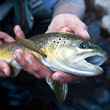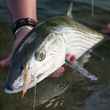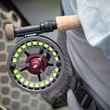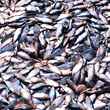I make a point of reflecting on my teaching efforts with the hope of becoming a better educator. This often means looking through past writing projects in search of things I failed to mention. One gap I quickly noticed was neglecting to highlight the importance of speeding up subsurface presentations, specifically when nymphing. There are numerous fly-fishing scenarios when we should ditch the idea of a natural dead drift and think about inducing drag to move the nymph faster than the current, as well as to create vertical movement towards the surface. Though there are several times when I feel a swung nymph presentation may outproduce a natural drift, one rises to the top: hatch time.
At the time of this writing, many of my favorite Pennsylvania trout streams are at peak insect level, with droves of caddis, mayflies, and stoneflies emerging throughout the day and into the darkness. While dry fly fishing is my preferred approach during this hatching “primetime,” nymphing tactics are still needed to produce results when fish are not feeding at the surface. While drifting nymphs naturally with the current (aka dead drift) provides the bulk of strikes during the year, the induced drift is often just as if not more effective during peak insect hatch periods since trout are conditioned to insects emerging towards the bank or surface.
Inducing your Nymph
An induced lift is accomplished simply by applying tension on the line which makes the nymph move towards the surface. Often this tension is applied at the end of presentation and is referred to as a swing. During the month of May on my home waters, when insect activity and ideal water temperatures have fish keyed in on emerging insects, I would say that over half my catches occur during the swing stage of the presentation.
This swing or induced lift can be achieved a number of ways but these two I use the most often.
The Basic Swing
The basic swing is employed by lowering the rod tip at the end of a nymphing drift and slowly pulling the flies towards your direction. Usually, I keep the rod tip low during the swing to keep the nymphs riding deeper in the water column. The advantage of the basic swing is the ability to swing the nymphs across a wide arc of water, allowing you to cover a lot of ground. You can consider this basic swing as a searching tactic and often I use this approach when I’m swinging through a nondescript body of water, where I don’t have a defined target like a bubble line or a seam. I often use this basic swing in wide shallow riffles or a wide tail out.
The Parallel Induced Lift
The concept of creating tension is the same with this tactic as it is with the basic swing. The major difference is that I’ll keep my rod tip held higher off the water and stop it over a specific seam I want my nymphs to remain in during the swung presentation. Think of it as a classic, dead-drift nymphing presentation where you simply move your rod tip over a distinct current or seam where you want to swing your nymph patterns. I use this tactic anytime I have a great looking seam, current, or bubble line where I want to keep my nymphs within during the swung presentation.
Patience is a Virtue
With either approach, it’s crucial that you patiently wait for the nymphs to swing all the way up towards the surface before beginning the next presentation. As someone who possessed little patience in my early fly fishing days, I rarely exhibited the restraint to allow my flies to fully swing up towards and to the surface before making my next cast. That is, until I realized that the majority of my strikes often occurred after the flies swung to the surface and dangled there for several seconds.

Wets Not Required
You don’t have to use wet flies to employ a swung presentation. Recently, I’ve moved to fishing a lot of single nymph rigs—using flies like pheasant tails and perdigons—and I still catch a lot of fish. If I start seeing an increase in both bug and fish activity, then I may add a soft hackle pattern. I think an important part to remember is you don’t always have to build movement into your flies like a soft hackle. Instead, you can induce movement into the pattern by using your rod hand to tap the rod blank during the swing-sending pulses into the fly. You can also wiggle the rod tip during the swing. The options are endless, but the point is sometimes excessive movement placed into the fly during the swing is a good thing.
Easy Does It
One of the hardest things to master during a swung presentation is gently setting the hook. Your nymph(s) are already under a high degree of tension during a swung presentation. Most often, the fish will hook itself when striking making it easy to overreact when one detects the aggressive tug characteristic of a trout or other fish taking a swung fly. The goal is to lift the tip with little force—just enough to squarely set the hook. Anything too aggressive will result in either breaking off the fly or ripping the fly out of the trout's mouth.
Wrapping Up
As we head into prime trout season, remember not to neglect the traditional swing or the induced parallel lift, as I believe this final stage of your presentation may prove to be the most useful during these times.





























Comments
Anonymous replied on Permalink
Everything old is new again. This sounds like the Leisenring lift to me. Jim Leisenring was a "market fisherman" in Pennsylvania back in the stone ages who employed this technique to profitable effect.
Glenn Dotter replied on Permalink
Anonymous, you are absolutely right. If you are from PA, you should know about Jim Leisenring! The wtiter gives Jim no credit for this productive tactic.
James replied on Permalink
Thank you for these hints. Very interesting.
Pages